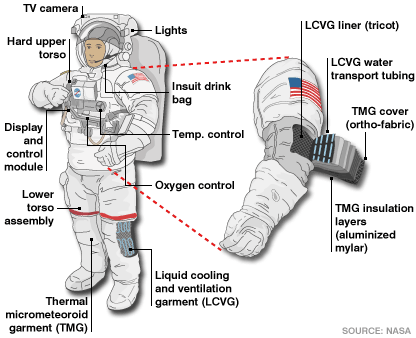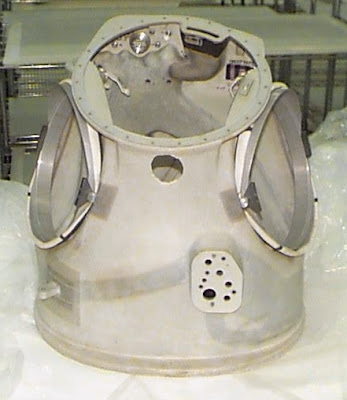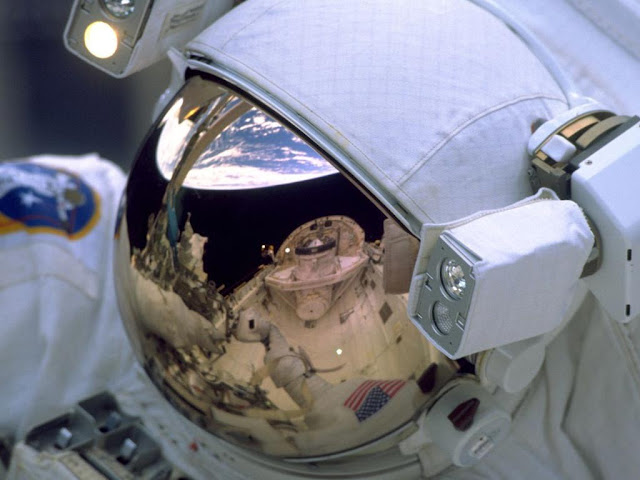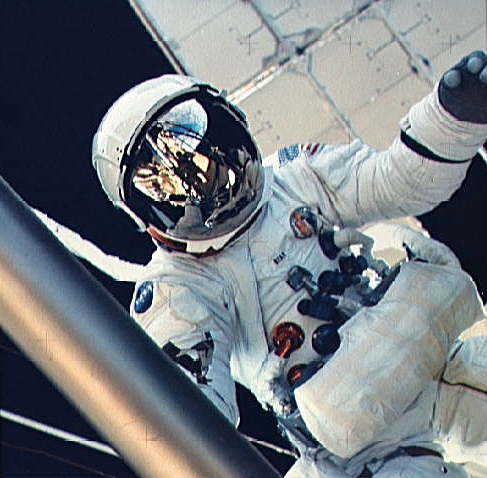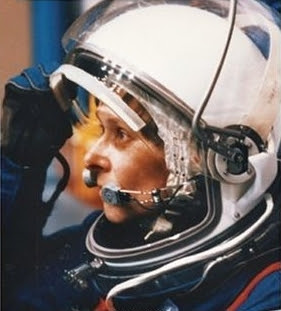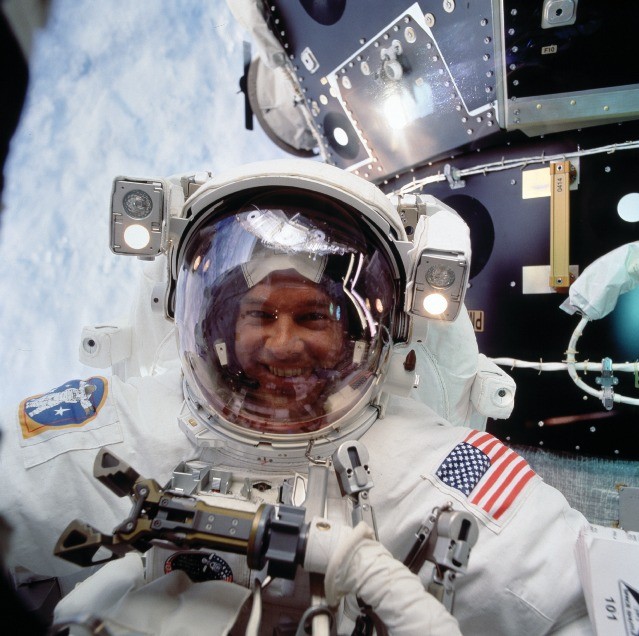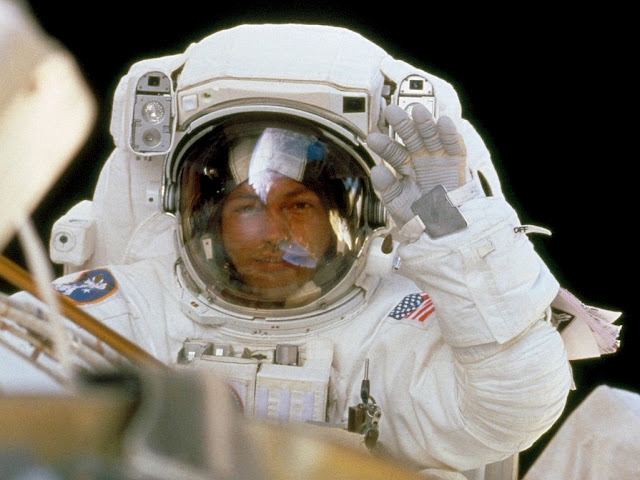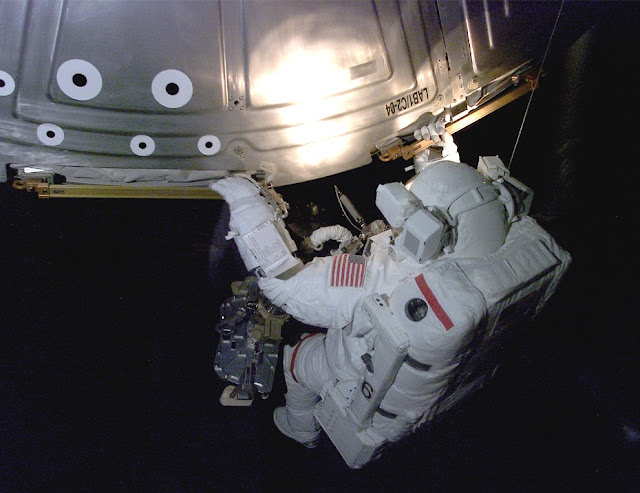NASA - Extra Vehicular Activity (EVA) patch.
Jan. 6, 2012
Design of the space suit
The EMU spacesuit crew of the Space Shuttle and ISS is gradually increased from 11 to 19 layers of protection to a thickness from about 5-8 mm. In its 2010 version, it consists of an assembly of 18 components produced by some 80 companies and assembled in the office headquarters in Houston, Texas. The size of the different elements varies between 8 mm and 76.2 cm for the water supply. ILC Dover tells us that a combination EMU requires about two and a half years of work about 5000 hours.
As we mentioned, many materials are components of the space suit. Many materials make use of synthetic polymers that can be found on the market and you may have.
The different layers of protection
The purpose of the space suit (or Space Suit Assembly SSA) is to protect the astronaut severe conditions prevailing in space: the absence of air, heat, cold, radiation and impacts of meteoroids and other debris. It includes two practical clothing: underwear body for comfort (LCVG) above which is the famous astronaut pressure suit comprising a succession of white insulating layers and protective layers (TMG).
The fabric inside the pressure suit is made of nylon thread as it is rot-proof, highly resistant, flexible, lightweight insulation. Perspiration that would result is evacuated through LCVG. The second layer is made of Spandex or Lycra (as LCVG).
Internal structure of a typical combination SSA carried by the crew of the space shuttle during the EVA. Its structure TMG has hardly changed for over 20 years. Document ILC Dover (http://www.ilcdover.com/Space-Suits/) adapted by the author.
Then the pressurized layer is nylon coated urethane (a foam-based ethane also known as carbamate). It is covered by a Dacron fabric that a type of polyester (it is used to manufacture such as canvas pants) that maintains structural layer pressurized.
Above is a non-slip nylon-covered neoprene which is a spongy material insulation (it is also the combination of scuba divers).
The five following layers but may be more likely provide protection called TMG. It is made of aluminized Mylar (which is also used to make sunscreens and insulating blankets) which assumes the role of thermal insulation and protection against cosmic rays. When it contains nylon it also protects against micro-meteoroids.
Finally, the outer layers are made of Ortho which is a blend of Gortex (it is also used to make boots), Kevlar (known to be bullet-proof) and Nomex to ensure good mechanical protection (against abrasion, wear, impact, tearing, etc.).
However, this combination offers no protection against high-energy particles (protons, electrons) released during solar flares (CME). In this case the astronauts need to take refuge in a shelter in the space shuttle and have the heat shield of the shuttle facing the sun.
The materials used to manufacture the combination are selected to prevent formation of mold or bacteria growth, for their strength and resistance. That is why we find synthetic fibers (polymers) and metal fibers. However after each flight, the combination is cleaned and dried.
The torso, gloves and boots
Under the protection of TMG, the upper part of the combination lies a hard shell called "Hard Upper Torso" (HUT) made of fiberglass. Its main purpose is to protect the vital parts of the body of the astronaut. He also comfort by supporting the PLSS backpack and various tools that attach to the torso (workstation, etc).
The HUT has four openings provided with fastening rings which attach the helmet, the lower torso (LTA) and the two arms (in fact the shoulders to the arms).
In addition, adapters were added to fix the connections of the PLSS and the display module and control DCM. The torso HUT has several receptacles receiving the bag of water, the communication system and vents and holes for the passage of cables and other supply lines.
All that hard is much more comfortable than previous models because the openings were expanded and placed closer to the body, outside the opening angle of the members, which has eliminated the flared rim, leaving more space to move my arms.
A general description of the combination ISS EMU without the SAFER.
Image above: The Hard Upper Torso (HUT). Note the tilt of the neck for easy close observation through the headphones. The base of the shell ends up in the abdomen.
The LTA
The lower part of the combination is called "Lower Torso Assembly" (LTA). It includes pants (size high, to the navel!), Boots and small parts protecting the lower abdomen and waist, knees and ankles. It is made of nylon protected by a layer Rethans and TMG.
In combination with low pressure, the joints are generally covered by a bellows which ensures free movement of the astronaut to the point that without the PLSS it would be a movement without experiencing hardship.
The gloves contain small heaters in each finger whose temperature is controlled by the astronaut and are stuffed with an insulating material.
The boots have the toes of an insulating protection to prevent heat loss. Socks equipped with resistors are also planned.
Because EVA can last almost nine hours, the combination has a system for collecting urine, both solid and liquid, the "Maximum Absorption Garment" (MAG). Older model combination could contain up to 0.95 liters of liquid. The current mix is using a kind of sanitary napkin much more convenient.
Finally, ring connection capable of supporting different levels of pressure are fixed at the ends of different segments (arm, thigh and leg) to unite with other parts tightly with the image of a bayonet. The closures are maintained by the latches locked, mechanical seals and tapes.
The display module and control
On the torso rigid set a display module and control, the "Display and Control Module" (DCM). It allows astronaut to control at any time the status of his suit and connections to external sources of liquids and electricity. It contains all the buttons or levers needed to stop or start the mechanical and electrical systems, adjust the level of pressurization, the valve of the primary purge oxygen and a digital display. This set is powered by a battery of 17 volt silver-zinc which also supplies other elements of the suit and the PLSS.
This module is integrated warning system located in the upper torso, whose role is to ensure that the astronaut knows the status of his suit. If necessary, the combination can be connected to the space shuttle with a cord. It is disconnected before the astronaut leaves the airlock (airlock).
The parts are interchangeable from the combination helmet, rigid upper torso, arms and the assembly of the lower torso.
DCM manufactured by Hamilton Sundstrand. The top is the foreground
As we have said, each pair of arms and legs are manufactured in different sizes which can be adjusted by varying the width of the mounting metal rings that unite the different segments. In this way the lengths of the arms and legs of the combination can be shortened or lengthened by adjusting the width of the rings at the sections of the arms and thighs. This adjustment may be about 2.5 cm to 7.5 cm up arms and leg.
An astronaut takes about 15 minutes to put on his suit. It must first put the LCVG including the cooling system and ventilation. Then he puts on the lower torso (legs and thighs) and then attach his boots. Subsequently, the astronaut fits inside the torso rigid which is already fixed the life support system which, given its weight, is suspended from a hook in the sas special dressing. All systems are then connected and the joints are secured. Astronaut can then put his gloves and helmet. Although in theory the astronaut can equip only in practice and for safety reasons, it actually helped.
The helmet
The helmet (and the means of survival that accompany) worn by the astronauts to protect them from the depressurization, the lack of oxygen and the risk to the vacuum of space. There are basically two models, one focused inside the cabin depressurized, the astronauts wear during maneuvers of the Space Shuttle (including the old model LEH said "clam shell), the other reserved for the EVA.
What we call the "helmet" they carry astronauts during EVA is in fact what NASA calls about the "Helmet Assembly" means a unit composed of two main components: the helmet itself, consisting of a pressurized bubble of glass, anti-shock, anti-fog that was already used by the Apollo crews, and a helmet cover (EVVA) used for protection and support for various accessories and can be seen in the photograph shown at below.
The helmet is manufactured by ILC Dover. It consists of several elements, mainly consisting of a shell more or less oval fiberglass that provides a field of view without any obstruction. The transparency of the visor is secured by the use of polycarbonate, a plastic polymer that replaces the glass as it is more solid and very durable under all variations of this term, including the impact. The visor is very thick, about 3 mm.
The polycarbonate (PC) is marketed under the name Lexan. This material is used to make motorcycle helmets, portholes divers "heavy feet" and the hulls of bike helmets.
The rear of the helmet of the astronauts is covered with an insulating layer of neoprene which is also an anti-shock absorbent and relatively light.
The helmet is equipped with a helmet cover called "Extravehicular Visor Assembly" (EVVA) whose function is to reduce the intensity of solar radiation that strikes the face of the astronaut exposed to direct sunlight. It slides manually and covers the entire surface of the visor. The EVVA also provides additional protection against micro-meteoroids and accidental impacts and protect the astronaut against UV radiation. A special coating made of a multilayer gold is attached to the visor. It is designed to reflect heat (IR) and light, while allowing the astronaut to see through. Adjustable eye protection can also be lowered over the visor to provide additional protection against the glare of the sun and glare.
The different types of helmets used by astronauts:
The helmet with the visor fitted EVVA golden combination A7L used by astronaut Alan Bean during the Skylab 3 mission in 1973.
The helmet worn by the astronaut Roberta Bondar during the STS-42 in 1992. It is not designed for EVA but only for environments with low air or depressurized.
Astronaut Jeffrey Williams with a combination EMU ISS during the STS-101 in 2000
The communication system or "Communications Carrier Assembly" (CCA) consists of several elements. As is done for the pilots, the communicator is a cap woven Teflon fiber (a polymer plastic with very little friction) and Nylon / Lycra (elastic and resistant) worn under the helmet. Nicknamed "Snoopy Cap" (Snoopy's cap), it has two headphones, a microphone and a duplex containing the electrical harness. It attaches with a chin strap. This communication system is attached to the radio placed in the top of the PLSS.
These means allow radio communications between all crew members. Medical information (EEG) also pass with telemetry (data theft techniques) in the CCA and are transmitted in real time on the ground, the Mission Control Center in Houston.
The transceivers used in the EVA have two UHF channels for the transmission of three channels for receiving and a simple switch. These radios have an antenna discrete called "low profile" placed in a box 30x11x9 cm above the PLSS. The set weighs 3.94 kg telecoms which is comparable with portable radios V / UHF trade (taking into account the headset).
Demonstration of the visor EVVA:
Astronaut Carlos Noriega during the STS-97 in 2000. Note his "Snoppy Cap" (cap B / W)
Astronaut Scott Parazynski during the STS-100 mission in 2001
A camera is mounted on the helmet cover to save the EVA. Two pairs of headlamps are arranged on both sides of the EVVA to illuminate the object that handles the astronaut example if he is forced to work in the background.
For years before the spacewalk, the astronauts would apply the inner surface of a visor anti-fog spray. That time has passed. Now, to prevent fogging or ice, an electrical lattice son is buried in the polycarbonate to warm. In addition, as we have explained, a small fan is attached to the back and inside of the helmet to deliver oxygen over the head of the astronaut.
In the helmet is also a mouthpiece (a straw) connected to a water bag (IDB), the astronaut can use if he is thirsty. This bag comes in two sizes and is placed in the top of the HUT. It can hold 21 or 32 ounces either 0.6 or 0.9 liters of water. This bag is secured with Velcro.
The transparent inner helmet is placed on a metal ring attachment containing 80 latches that can secure it to the hard upper torso of the suit. Unlike the helmet of Mercury and Gemini suits that turned at the same time as the head of the astronaut from the Apollo missions to the helmet, in theory, could rotate 360 degrees, was fixed when locked to the HUT, which should not increase the feeling of being like a fish in a jar.
Demonstration of the lighting:
Astronaut Carlos Noriega during the STS-97 in 2000
Astronaut Daniel Barry during STS-105 in 2001. It is at a handrail attached to the Destiny laboratory to ISS
The helmet and visor are usually made using the classic technique of molding preformed. Polycarbonate beads are injected into a mold where they are melted and made to form the approximate size of the helmet. When the mold is opened, the main room of the helmet is crafted. It remains to him attach the metal ring mounting, ventilation system, the bleed valve that uses the astronaut with oxygen supply, communication system, the EVVA, headlamps, outdoor camera TMG protection.
Quality control
The manufacturing process of EMU spacesuit is complex. It can be divided into two phases of production. First of all plants confection individual elements. Then they are sent to NASA where they are assembled in factories classics. At this stage of production, the combination is no longer EMU tested in vacuum and can be paid directly by astronaut training for his or her duties.
Quality control is performed at each stage of production process. It ensures that each piece is manufactured in strict compliance with the standards defined in the specifications and operate in the harsh environment of space.
NASA also results of tests completed in the combination of environmental conditions and in vacuum. We check in particular if there is no air leakage, depressurization or malfunction of the system to survive. This quality control is important because the most trivial failure can have dramatic consequences for astronauts exposed to vacuum and the fires of the sun.
The lifetime of a combination of last generation ISS EMU is about 15 years and certified for 25 EVA with routine maintenance between flights. Like the old Apollo suits, it tends to deteriorate and it is estimated that the first models were shattered after about 30 years to 2010. Today we have no solution for this problem and engineers are studying new materials more stable. On the other hand this period is long enough because the combination will in any case outdated technologically and advantageously replaced by more appropriate models, generally lighter, stronger and more compact.
Related links:
The NASA spacesuit evolutions: http://www.nasa.gov/externalflash/spacesuit_gallery/index_noaccess.html
NIX: http://nix.nasa.gov/
Spaceflight: http://spaceflight.nasa.gov/
Hamilton Sundstrand: http://www.hamiltonsundstrand.com/
NASA/ARC: http://quest.arc.nasa.gov/
ILC Dover: http://www.ilcdover.com/
Images, Text, Credits: NASA / ARC / NIX / Hamilton Sundstrand / Spaceflight / Orbiter.ch.
Best regards, Orbiter.ch


